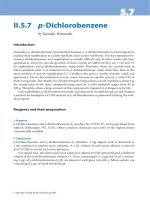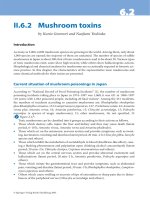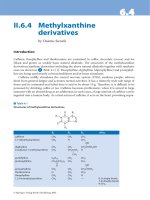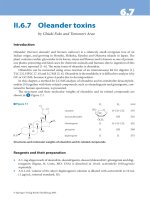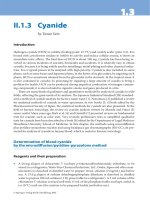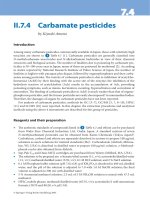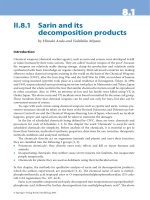A History of Vascular Surgery - part 1 docx
Bạn đang xem bản rút gọn của tài liệu. Xem và tải ngay bản đầy đủ của tài liệu tại đây (367.3 KB, 24 trang )
A History
of Vascular
Surgery
SECOND EDITION
Always,
Heidi
A History
of Vascular
Surgery
SECOND EDITION
Steven G. Friedman,M.D.
Chairman, Department of Surgery
NYU Downtown Hospital
New York, New York
and
Associate Professor of Surgery
New York University Medical School
New York, New York
© 2005 by Futura, an imprint of Blackwell Publishing
Blackwell Publishing, Inc., 350 Main Street, Malden, Massachusetts 02148-5020, USA
Blackwell Publishing Ltd, 9600 Garsington Road, Oxford OX4 2DQ, UK
Blackwell Publishing Asia Pty Ltd, 550 Swanston Street, Carlton, Victoria 3053, Australia
All rights reserved. No part of this publication may be reproduced in any form or by any
electronic or mechanical means, including information storage and retrieval systems, without
permission in writing from the publisher, except by a reviewer who may quote brief passages in a
review.
02 03 04 05 5 4 3 2 1
ISBN: 1-4051-2522-5
Catalogue records for this title are available from the British Library and Library of Congress
Acquisitions: Steven Korn
Production: Julie Elliott
Typesetter: SNP Best-set Typesetter Ltd., Hong Kong
Printed and bound in the United States by Sheridan Press, Inc.
For further information on Blackwell Publishing, visit our website:
www
.blackwellfutura.com
www.blackwellpublishing.com
Notice: The indications and dosages of all drugs in this book have been recommended in the
medical literature and conform to the practices of the general community. The medications
described do not necessarily have specific approval by the Food and Drug Administration for use
in the diseases and dosages for which they are recommended. The package insert for each drug
should be consulted for use and dosage as approved by the FDA. Because standards for usage
change, it is advisable to keep abreast of revised recommendations, particularly those concerning
new drugs.
Contents
Foreword to first edition, vii
Foreword, ix
Preface, xiv
Part 1 Origins
1 Vascular surgeons of antiquity, 3
2 Early vascular repairs and anastomoses, 14
Part 2 The British are coming
3 William Hunter, 31
4 John Hunter, 35
5 Astley Cooper, 41
Part 3 Divisions of vascular surgery
6 Development of the venous autograft, 53
7 Evolution of aortic surgery, 74
8 Operation on the carotid artery, 89
Part 4 Yankee ingenuity
9 Valentine Mott, 107
10 Rudolph Matas, 112
11 The arterial prosthesis: Arthur Voorhees, 119
Part 5 More divisions
12 Contributions from the battlefield, 131
v
13 Venous surgery, 147
14 Extra-anatomic bypass, 161
Part 6 The French connection
15 Mathieu Jaboulay, 171
16 Eugène Villard, 173
17 Alexis Carrel, 175
18 René Leriche, 184
19 Jean Kunlin, 188
20 Charles Dubost, 192
21 Jacques Oudot, 197
Part 7 Endovascular surgery
22 Charles Dotter: interventional radiologist, 203
23 Thomas Fogarty, 214
24 Juan Parodi, 220
Index, 224
vi Contents
Foreword to first edition (abridged)
Steven Friedman approached me approximately three years ago and asked if I
thought there was a need for a book devoted to the history of vascular surgery.
My response, I believe, was that there is always a need for a good book on
any subject. Before responding further, I searched my memory for any books de-
voted to the broad topic of vascular surgery. There was not an overwhelming
number. There were some books devoted to specific areas within vascular
surgery such as varicose veins, cerebrovascular disease, and peripheral arterial
disease. There was only a small number of textbooks of vascular surgery. To
attest to the youth of the specialty and the rapid technical changes occurring
within it, there were more atlases of vascular operations than there were
textbooks. The few books devoted to the history of vascular surgery were
short biographies of some of its more illustrious pioneers. Afew condensed his-
tories appeared in surgical journals, usually written as a Presidential Address
by one of the modern pioneers. With those thoughts in mind, I could truthfully
respond to the aspiring author that there was a need for a book devoted to “A
History of Vascular Surgery.”
The plan for the book was to follow the progress of vascular surgery from
antiquity to the present. The emphasis was to be on the accomplishments of
individuals. The question of who the individual was, what he did, and the im-
portance of his contribution was, for the most part, to be learned in the library.
Whenever possible, surgeons responsible for the recent developments were to
be interviewed. To accomplish this, the author read over 90 percent of the origi-
nal or translated articles in his bibliography and interviewed over twenty-five
contemporary vascular surgeons.
I have had the opportunity of reading the entirety of the author’s contribu-
tion on two occasions. The first draft of each chapter has arrived in my office reg-
ularly every few months during a period when the author was completing his
residency and establishing a practice. As residents with whom I have written
papers can attest, my technique for reviewing papers is simple. I rewrite what I
don’t like and add some suggestions for minor changes. I next saw these chap-
ters in the final manuscript submitted for publication. I was very impressed. I
found a finished product that embodied thought-provoking quotations preced-
ing each chapter, accurate reporting, interesting excerpts from the lives of the
pioneers, and the sources of many familiar quotations. The book was of reason-
able length and more than covered the highlights of the history of vascular
surgery. The flavor of the author’s style appeared throughout the book and
none of my rewritten paragraphs were to be found.
One of the most pertinent quotations appears at the beginning of the chapter
vii
on Recent Advances. Henry L. Ellsworth, Commissioner of Patents in 1843,
stated: “The advancement of the arts from year to year taxes our credulity and
seems to presage the arrival of that period when human improvement must
end.” The incorrectness of that statement has been emphasized by the continual
advances which have occurred in vascular surgery since 1843 and the realiza-
tion that the Fogarty catheter, balloon angioplasty, and laser surgery are just the
beginning of many more improved techniques available to the vascular sur-
geons of the future.
James A. DeWeese, M.D.
Professor of Surgery
Chairman Cardiothoracic Division
University of Rochester
School of Medicine and Dentistry
Rochester, New York
1989
viii Foreword to first edition (abridged)
Students of medical history and practitioners should take delight in reading
this new edition of Steven Friedman’s AHistory of Vascular Surgery. If the author
was considered to be an aspiring writer with the publication of his original text
in 1989, he must now be recognized as an accomplished contributor to our
understanding of the historical underpinnings of one of medicine’s newest
disciplines – vascular surgery. Afew tidbits reflect the breadth of this book.
Sushruta, a talented and productive surgeon from the subcontinent of India
who lived more than 2500 years ago, is described as the first to discuss the con-
trol of bleeding vessels in a systematic manner (Chapter 1). He was also clear in
his condemning those who performed the wrong operation because of mistakes
or a lack of skill, as well as for greed. His statement on incompetent surgeons has
become increasingly relevant in our contemporary times of greater physician
accountability. The simple control of bleeding by Celsus, Antyllus, and Galen
characterized vascular surgery during antiquity. More complex interventions
were heralded by Richard Lambert, who was among the first to describe an
actual vascular reconstruction when he reported Hallowell’s 1759 approxima-
tion of the margins in an arterial wound, an observation that changed the
practice of organ- and limb-threatening ligation to a reconstructive mode
(Chapter 2). Nearly a century later, John Murphy performed the first successful
arterial reanastomosis in 1897.
Contributions of the Scottish brothers William Hunter and the younger John,
born in the early 1700s, and the Englishman Astley Cooper, born in the mid-
1700s, directed the attention of clinicians to the treatment of vascular diseases
other than bleeding associated with trauma (Chapters 3 and 4). All three con-
tributed important insights into the recognition of aneurysmal disease and its
treatment, albeit by simple ligature. If there was ever a story of redemption, Ast-
ley Cooper, who self-proclaimed that he “had a way with the girls,” certainly
would be in the forefront (Chapter 5). He was considered to be a sad rogue as a
medical student and even characterized himself as an “idle rollicking, ne’er-do-
well.” Obviously, he redeemed himself in his later days, having been recognized
as a Baron by the King of England for his contributions to the surgical sciences.
Use of autologous vein to replace or bypass diseased and injured arteries
signaled the beginning of modern vascular surgery nearly 100 years ago in the
publications of Alexis Carrel and Charles Guthrie (Chapter 6). Although Jose
Goyanes interposed a popliteal vein in place of a popliteal aneurysm in 1906, it
was four decades before the success of using reversed vein for arterial recon-
structions became established, and another two decades before in situ recon-
structions became popular in clinical practice.
Foreword
ix
Nearly two centuries passed from the days of treating aortic aneurysms by
ligation to the present-day era of successful endovascular graft placement
(Chapter 7). During the interim period, many vascular surgeons successfully
treated aortic disease with homografts. Although the history of these last con-
duits was short-lived, their use led to improved operative techniques that soon
thereafter made the insertion of synthetic aortic prostheses an attractive and
seminal event in the evolution of vascular surgery.
The history of carotid artery surgery is remarkable if only for the centuries of
overlooking the extracranial portion of this vessel as a source of emboli causing
stroke (Chapter 8). It was only with the development of imaging by Egas Moniz
and with Miller Fisher’s autopsy study recognizing that most strokes had an
embolic cause that carotid revascularization became a clinical reality. Michael
DeBakey’s performance of the first successful carotid endarterectomy in 1953
was not reported at that time. Instead, clinical interest in carotid artery recon-
structive surgery actually evolved after the 1954 report of Felix Eastcott, George
Pickering, and Charles Rob, who resected a carotid bifurcation and performed a
primary reanastomosis for an obstructing arteriosclerotic lesion. Four decades
passed before the efficacy of carotid endarterectomy was firmly established by
the North American Symptomatic Carotid Endarterectomy Trial (NASCET)
and the Asymptomatic Carotid Atherosclerosis Study (ACAS) prospective
clinical trial. Similar studies will be required to define the value of catheter-
based carotid artery angioplasty and stenting.
Valentine Mott was one of America’s first vascular surgeons (Chapter 9). He
trained for 6 months with Astley Cooper in England and then returned to New
York, where, at the age of 28, he became the first Chairman of Surgery of the
merged Columbia College and College of Physicians and Surgeons in 1813.
Mott’s legacy was in treating vessels arising from the aortic arch and terminal
abdominal aorta. Just as remarkable was his death at 80, when his overall health
precluded amputation of a gangrenous leg.
Successful treatment of many aneurysms became more commonplace under
the aegis of Rudolph Matas (Chapter 10). This American surgeon, born in
Louisiana, had lived in France and Spain before returning to his home state,
where he obtained his medical degree at the age of 19 in 1880. His early work at
the Charity Hospital in New Orleans provided ample opportunity to treat trau-
matic aneurysms. It was in this environment that he perfected the technique of
aneurysmorrhaphy, which allowed maintenance of distal flow in the affected
artery. Shortly after the turn of the 20th century, Matas underwent an eye enu-
cleation for infection. Loss of binocular vision certainly did not encumber his
surgical prowess. Toward the end of his career, he reported more than 600 opera-
tions for aneurysms, of which 101 were variations on aneurysmorrhaphy. It was
most unfortunate that he lost his remaining eye from complications of cataract
surgery, rendering him blind for the last 5 years of his life until he died at the age
of 97 in 1957.
Arthur Voorhees was an example of one of vascular surgery’s most impor-
tant innovators. Although it is reported that he struggled in undergraduate
x Foreword
school and medical school, he made up for his travails by recognizing the im-
portance of an error in an experiment that he had been responsible for during his
residency (Chapter 11). The appearance of a misplaced ventricular silk suture in
a dog’s heart suggested that implantable devices could develop nonthrombo-
genic surfaces, and his subsequent insertion of vinyon-N prosthetic aortic grafts
followed this observation. His laboratory work and the results of grafts inserted
in humans were presented in 1953, 8 years after he had graduated from medical
school. This work represented a singular triumph of surgical science.
Lessons learned from the battlefield regarding vascular surgery were slow in
coming (Chapter 12). Like many other marks of progress, serendipity and luck
played an important role. In 1536, Ambroise Paré, having exhausted his oil sup-
ply for cauterization in the battlefield, used what he thought was a poor substi-
tute, only to recognize a day later that this was a much more effective manner of
treating vascular wounds. His use of ligatures followed. This approach contin-
ued until World War II, when the high amputation rate accompanying vascular
injuries was considered to be unacceptable. This caused the Walter Reed Army
Hospital Group in 1949 to consider battlefield vascular repairs. Speedy
transport of patients to mobile army surgical hospital (MASH) units and the
expertise of surgeons during the Korean conflict overseeing this rather radical
departure from the dogma of earlier centuries allowed reconstructive surgery
to replace earlier nihilistic therapies.
The history of treating venous disease is remarkable for the lack of change
(Chapter 13). Socrates was the first to recommend compression bandages, and
Galen suggested the excision of varicosities. All of this occurred over 15 cen-
turies ago. The mainstay of treatment remained compression. It was not until
the importance of communicating veins was recognized by John Holmans in
1916, and their interruption by Robert Linton in 1938, that treatment of venous
insufficiency changed. Bypass reconstructions within the venous system were
undertaken sporadically during the past 50 years, being first reported in 1952 by
Palma. Under appropriate circumstances, venous reconstructive surgery,
including implantation of autologous valves removed from other locations,
benefits properly selected patients.
Extra-anatomic or nonanatomic reconstructions represented a major redirec-
tion in the practice of vascular surgery, being first described by Norman Free-
man in 1952 and subsequently popularized by many others (Chapter 14). The
first axillary femoral bypass was undertaken by William Blaisdell in 1962 as an
urgent alternative to a more major procedure in a patient experiencing a my-
ocardial infarction in the operating theater. For a brief time, an axillary femoral
bypass was thought to be advantageous over direct aortic surgery. This has not
proven to be the case, but clearly these alternative procedures have provided life
and limb salvage in patients who could not tolerate more direct arterial recon-
structive procedures.
Two groups of French vascular surgeons have made many contributions to
vascular surgery. The first group includes Drs. Jaboulay, Villard, Carrel, and
Leriche. These individuals, born between 1860 and 1879, made many sentinel
Foreword xi
observations that advanced vascular surgery into the next century. Mathieu
Jaboulay was one of the first to evert the edges of an artery anastomosis, elimi-
nating the thromboses that compromised earlier closures (Chapter 15). Eugène
Villard, like Jaboulay, carried out many experimental canine studies and was
one of the first to describe characteristic changes of veins interposed into the ar-
terial circulation (Chapter 16). Alexis Carrel clearly defined perfection in vascu-
lar anastomoses (Chapter 17). His work with Charles Guthrie at the University
of Chicago represented one of the most prolific times in the history of vessel wall
replacements and was, in part, the basis for his receiving the Nobel Prize in 1912.
The latter part of his life was one of bitterness, beginning with his forced
retirement from the Rockefeller Institute at age 65 and insinuations that
he collaborated with the Germans during World War II. Both robbed science and
medicine of a brilliant mind, which would have likely continued to benefit
mankind had these distractions not occurred. Lastly, René Leriche, who was a
medical student when Carrel was a chief resident and who was taught by
Jaboulay, wrote over 1000 papers involving surgery and physiology (Chapter
18). Although his observations, which began as early as 1923, on thrombotic
occlusion of the terminal aorta carry his name, he was very reticent about
supporting reconstructive arterial surgery.
The second group of French vascular surgeons included Drs. Kunlin,
Dubost, and Oudot. These three individuals undertook the first successful
lower extremity bypass and reconstructions of the aortoiliac segment for both
aneurysmal and occlusive disease. In 1948, Jean Kunlin, who was a trainee and
then an assistant to Leriche, undertook a femoral popliteal bypass with saphe-
nous vein when Leriche was traveling outside France (Chapter 19). Kunlin sub-
sequently presented eight similar cases that same year, and changed forever the
surgical approach to profound lower extremity ischemia. Charles Dubost was
the first to resect an aortic aneurysm and replace it with a homograft in 1951
(Chapter 20). The patient survived for 8 years following surgery. This accom-
plishment radically changed the perception of vascular surgery’s potential. Du-
bost was an exceedingly talented surgeon who also made many contributions to
the surgical treatment of heart disease, having been involved with more than
15 000 cardiac procedures and with the first in Europe to use the heart–lung ma-
chine. Jacques Oudot made important observations in the experimental labora-
tory regarding aortic occlusive disease and the physiologic effects of aortic
clamping. He rapidly applied his knowledge to the management of aortoiliac
occlusive disease by successfully treating such a patient with a bypass in 1950.
This was a triumph of intellect and courage. These three French surgeons had a
major impact on stimulating later advances in vascular surgery that were to em-
anate from the western hemisphere.
Catheter-based treatment of vascular disease has caused near cataclysmic
changes in clinical practice. Three individuals, Drs. Dotter, Fogarty, and Parodi,
have made seminal contributions to the new discipline of endovascular surgery.
Charles Dotter deserves the title of the father of interventional radiology (Chap-
ter 22). He completed his training and had an early academic appointment in
xii Foreword
New York at Cornell University, before becoming Chairman of Radiology at the
University of Oregon at age 32, a position he held for a further 32 years. An inad-
vertent recanalization of an occluded iliac artery led to the concept of percuta-
neous transluminal angioplasty, which he successfully performed for the first
time in 1964 in a patient with lower extremity occlusive disease. Dotter was also
the first to undertake intra-arterial fibrinolysis, and he was the first to describe
intravascular stents. He was often characterized as a cantankerous individual
who changed the practice of medicine. Thomas Fogarty is best known for the
development of the balloon catheter for extracting emboli and thrombi from
acutely occluded vessels (Chapter 23). It is interesting that as a resident in car-
diothoracic surgery at the University of Oregon he created the first balloon
catheter used for iliac artery dilation by Dotter. As an entrepreneur in bringing
surgical instrumentation to the patient, Fogarty has more than 100 patents and
has founded more than 40 medical companies. He has no peer in this regard. The
last of the three innovators in intravascular interventions is Juan Parodi (Chap-
ter 24). After completing a surgical residency in his home country of Argentina,
he embarked on further training at the University of Illinois and at the Cleve-
land Clinic. Dr. Parodi conceived the idea of endovascular graft placement for
the treatment of aortic aneurysms. He undertook the placement of these grafts
in 53 dogs with excellent results. This achievement led to the first clinical appli-
cation of the technology, when in 1990 he performed the first successful en-
dovascular repair of an abdominal aortic aneurysm in a human. This seminal
work was a direct result of Dr. Parodi’s creativity and early persistence in bring-
ing this technology to clinical practice. His accomplishment transformed the
practice of vascular surgery.
This gem of a book, with its many illustrations, bibliographic references, and
unique organization, details the accomplishments of many well-known indi-
viduals who have practiced vascular surgery from the times of antiquity to the
present, and it offers tantalizing insights into others not readily recognized in
discussions of this specialty’s heritage.
James C. Stanley, M.D.
Professor of Surgery
Head, Section of Vascular Surgery
University of Michigan
Ann Arbor, MI
2004
Foreword xiii
Since the publication of the first edition of A History of Vascular Surgery in 1989,
vascular surgery has been transformed. Technical innovations, beginning with
Parodi’s seminal endovascular aneurysmorrhaphy, have rapidly accelerated
the evolution of our young specialty. The major vascular societies are merging to
better serve our specialty and our patients, and we are grappling with profound
changes in the way we train vascular surgeons. As these events unfold, it is an
opportune time to update this history of vascular surgery. To chronicle the cas-
cading advances of the past 15 years, 6 of the 13 chapters from the first edition
have been revised and 11 new chapters added. Amalgamation of these two eras
revealed a common thread: the continuous presence of dauntless innovators.
Whether you “caught the fever” from the first edition or missed it completely,
here is your second chance.
Steven G. Friedman, M.D.
2004
Preface
xiv
PART 1
Origins
Vascular surgeons of antiquity
3
It [surgery] is eternal and a source of infinite piety, imparts fame and opens the gates of
Heaven to its votaries, prolongs the durations of human existence on earth, and helps men in
successfully fulfilling their missions, and earning a decent competence, in life.
(Sushruta)
Man has always had to face the problem of hemorrhage. Vascular surgery began
with the first attempt to control a bleeding vessel. A compelling body of evi-
dence indicates that Sushruta (Figure 1.1), the great surgeon of ancient India,
first practiced ligation of blood vessels. Although Sushruta’s place in historical
time is debated among medical historians, most scholars of ancient Indology
place it between 800 and 600
BC.Sushruta was the first great surgeon of antiquity,
and his monumental treatise, Sushruta Samhita, was the first surgical textbook.
Although the original manuscript has been lost, several translations from the
Sanskrit have survived.
Sushruta divided his Samhita into six parts covering all branches of
medicine, but considered surgery the first and foremost. His contributions
to vascular surgery included the use of hemp fibers to tie blood vessels, applica-
tion of the cautery and boiling oil to check hemorrhage, and precise instruction
for the performance of amputations. Sushruta also pioneered phlebotomy
as a medical treatment and described four ways of arresting hemorrhage
after its use: application of astringents made from tree barks (sandhana),
thickening the blood by application of severe cold (skandana), drying the
wound with ashes (pachana), and cauterizing veins to make them shrink
(dahana). Although it is uncertain whether Sushruta specifically used catgut
ligatures, they were employed by several of the prominent Hindu surgeons who
succeeded him.
Sushruta’s brilliance was evidenced by his contributions to nearly every
present-day field of surgery. He performed rhinoplasty, laparotomy, tonsil-
lectomy, hernia repairs, vesicolithotomy, and anal fistulotomies, in addition
to many other procedures (Figure 1.2). Sushruta may have also unwittingly in-
spired the first malpractice attorney with his chapter from Samhita concerning
“defective surgical operations”:
Aphysician (surgeon) making a wrong operation on the body of his patient either
through a mistake, or through the want of necessary skill or knowledge, or out of
greed, fear, nervousness, or haste, or in consequence of being spurned or abused,
should be condemned as the direct cause of many new and unforeseen maladies. A
patient, with any instinct of self-preservation, would do well to keep aloof from such a
physician, or from one who makes a wrong or injudicious application of the cautery,
and should shun his presence just as he would shun a conflagration or a cup of fatal
poison.
The surgeons of Ancient Greece did not use the ligature for control of hemor-
rhage. They did, however, apply various mixtures of verdigris, antimony, and
lead sulfate directly to bleeding wounds. A “hemostatic button,” or circular
wad of copper sulfate, was also used in this manner. In the fourth century
BC, Hippocrates instructed that amputations be performed through the
gangrenous part to avoid bleeding. When hemorrhage was encountered,
however, he counseled: “Cold must be applied . . . not however to the part itself,
but to the parts adjoining.”
One of the earliest attempts at compiling a complete history of medicine was
made by Celsus during the first century
AD. Concerning the treatment of hemor-
rhage, Celsus advised the use of linen pledgets soaked in cold water and com-
pressed into the wound. If this failed, vinegar was to be applied. In the worst
situation, Celsus instructed that the cautery be used or that:
the bleeding vessel should be take up, and ligatures having been applied above and
below the wounded part, the vessels are to be divided in the interspace that thus they
may retract while their orifices remain closed.
During the second century AD, Rufus of Ephesus wrote five books of medi-
cine. In addition to describing the importance of palpation of the pulses for
4 Chapter 1
Figure 1.1 Sushruta, Surgeon of Old India (from Parke, Davis & Co. A History of Medicine in
Pictures, 1958).
diagnosis, he detailed several ways to treat hemorrhage. These included com-
pression, styptics, cautery, and twisting the arteries to occlude them. Rufus also
used the ligature.
Antyllus was also a second-century physician esteemed by his contem-
poraries. Osler described him as one of the most daring and accomplished
surgeons in history, chiefly because of his descriptions and treatment of
aneurysms. Antyllus described two forms of these lesions: those originating
from a local dilation in an artery, which were cylindrical, and those resulting
from trauma, which were rounded. He accurately described proximal and distal
ligation of aneurysms, as well as evacuation of the sac. Antyllus was ahead of his
Vascular surgeons of antiquity 5
Figure 1.2 Surgical instruments of Sushruta (from Prakash UBS. Sushruta of ancient India. Surg
Gynecol Obstet 1978; 146: 263).
time and his treatment of aneurysms was largely forgotten until Rudolph Matas
resurrected it 17 centuries later.
The most eminent surgeon of ancient Rome was Claudius Galen “the
Clarissimus” (Figures 1.3 and 1.4). During the second century, he studied phi-
losophy and medicine in Pergamon. Galen recognized the differences between
arteries and veins, and devised specific techniques for achieving hemostasis in
each. As surgeon to the gladiators for 3 years, Galen obtained much experience
treating bleeding. For venous hemorrhage he used a variety of styptics; for
arterial hemorrhage he used the ligature. Galen was a prolific writer and even-
tually authored more than 300 books. Among his more familiar observations
was that “common sense” was a misnomer, since it was far from common.
Two aggressive surgeons of the third century were the twin brothers Cosmas
and Damian (Figure 1.5). They were born in Cilicia, Asia Minor, and became
famous physicians who performed great deeds of charity, never accepted a
fee, and always defended Christ’s teachings. Legend has it that Cosmas and
Damian were the first to attempt anastomosis of blood vessels. An elderly ser-
vant of the church was afflicted with cancer of one of his legs. Following a long
prayer to one of his patrons, the servant fell asleep and Cosmas and Damian
appeared before him with their surgical instruments. The brothers amputated
his diseased leg and remembered that a Moor slave had been buried that same
day at St. Peter’s cemetery. Cosmas and Damian rushed to the slave’s grave,
6 Chapter 1
Figure 1.3 Galen: Influence for 45 Generations (from Parke, Davis & Co. A History of Medicine in
Pictures, 1958).
exhumed the body, amputated the dead man’s leg, and attached it to their
patient’s stump. The church servant awoke with one black and one white leg.
Unsure of whether or not he had been dreaming, the servant went to the cemetery
where the Moor’s body was surrounded by a crowd of curious onlookers. Next to
the slave lay the servant’s diseased white leg. As a result of this and other mira-
Vascular surgeons of antiquity 7
Figure 1.4 Surgical instruments of Galen’s time (from Major RA. A History of Medicine. Springfield,
IL: Charles C Thomas, 1954).
cles, Cosmas and Damian became the Christian saints of surgery. Although there
are several accounts of their deaths, the most widely accepted is that they were
executed by the sword in
AD 287 by the governor of Lycia, when they refused to
submit to idolatry. Cosmas and Damian died martyrs and are commemorated in
numerous Renaissance paintings and frescos (Figures 1.6 and 1.7).
Among the great Byzantine medical writers was Aetius, who lived in the
sixth century in Amida, along the Tigris River. His works consisted of 16 books,
8 Chapter 1
Figure 1.5 Miracle of S.S. Damian and Cosmas by Fernando Gallego (from Major RA. A History of
Medicine. Springfield, IL: Charles C Thomas, 1954).
and in one he described the treatment of brachial artery aneurysms by proximal
ligation. Aetius also was the first to ligate varicose veins.
Paulus Aegineta employed the ligature for treatment of varicose veins in a
manner similar to Aetius’s in the seventh century.
Albucasis of Cordova was a 10th-century Arabian surgeon who described
four methods of stopping the discharge of blood from an artery: cautery,
division of the artery across, use of the ligature, and styptics and bandage
(Figure 1.8).
In the 11th century, Roger of Palermo employed styptics and the ligature to
obtain hemostasis. He also described the “mediate ligature,” a threaded needle
used to suture and ligate blood vessels.
Vascular surgeons of antiquity 9
Figure 1.6 The Miracle of St. Cosmas and Damian (from the School of Bellini. Courtesy of the
Bettman Archive).
The premodern history of vascular surgery concluded with the contributions
of the greatest surgeon of the Renaissance, Ambroise Paré (Figure 1.9).
Paré established the ligature as an effective treatment of hemorrhage.
Born in Mayenne, France, in about 1510, Paré’s initial training began in a
barbershop and was followed by a 3-year residency at the Hotel Dieu. From 1536
to 1545, Paré acquired great experience in military surgery during the
Italian campaigns. Although the ligature had been described more than two
centuries earlier, Paré’s greatest undertaking was reintroducing it as the
preferred treatment for injured blood vessels. Paré discouraged the use of
boiling oil after his supply was exhausted during a particularly fierce battle.
Paré also disdained the application of a hot iron and treatment of wounds
with bandages only. He was gratified to discover improved results with
the ligature. In 1552, inspired by Galen’s description of the ligature, Paré first
used it for hemostasis. His patient was a military officer requiring lower-
extremity amputation owing to wounds sustained in Damvilliers. Paré
reported the case as follows:
10 Chapter 1
Figure 1.7 The Martyrdom of St. Cosmas and St. Damian by Fra Angelico (from Castiglioni A. A
History of Medicine. New York: Alfred A. Knopf, 1947).



